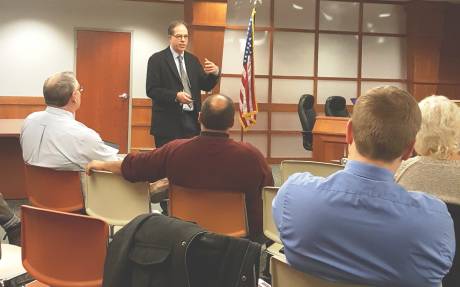City leaders learn about NYSERDA's grant-funded Clean Energy Communities Program

City of Batavia leaders are exploring the possibility of receiving up to $100,000 in grant funding through the New York State Energy Research and Development Authority’s Clean Energy Communities Program.
Public Works Director Matt Worth, Maintenance Superintendent Ray Tourt, Waste & Wastewater Superintendent Jim Ficarella and City Council members Adam Tabelski and Rose Mary Christian attended an hour-long presentation Monday night to learn the ins-and-outs of the program, which recognizes and rewards local governments for implementing a clean energy strategy.
The CECP is a $16 million statewide initiative to help municipalities reduce energy consumption and drive clean energy use, said David S. Zorn, executive director of the nine-county Genesee/Finger Lakes Regional Planning Council and regional program coordinator.
Of that $16 million, $1.7 million in grants has been allocated to communities in the Genesee/Finger Lakes Region that achieve “Clean Energy” status.
Local governments that achieve at least four of 10 “high-impact actions” will earn CEC designation and then be eligible to access the grant funding, Zorn said.
“We will provide the resources and technical assistance to help local governments take action that could result in significant money saved at the municipal level, and also create jobs and improve the environment,” he said. “And we’re not just throwing a manual to you or giving you a link to a website. We actually have people in our office to assist you.”
Zorn outlined the 10 high-impact actions during his presentation at City Centre Council Chambers.
He said that Batavia, as a city, would be able to choose any of the 10 in its effort to obtain a grant for small/medium populations (under 39,999 people). He said that four $100,000 grants and 10 $50,000 grants will be awarded to communities in that population range in the Genesee/Finger Lakes Region -- and no local match would be required.
For large population centers (40,000 and over), NYSERDA will be awarding two grants of $250,000, and two grants of $150,000.
The 10 high-impact actions are as follows:
-- Benchmarking: Using the EPA (Environmental Protection Agency) portfolio manager software, the community reports the energy use of municipal buildings to the public on an annual basis.
-- Clean Energy Upgrades: The municipality must achieve a 10-percent reduction in the greenhouse gas emissions from its buildings through upgrades and renewable energy.
-- LED Street Lights: One of the “poster children” of the program, according to Zorn, this action item requires the locality to convert at least half of its cobra head-style street lights to energy-efficient LED technology.
-- Clean Fleets: Communities must install an EV charging station and/or other alternative fuel infrastructure OR deploy alternative fuel vehicles in the municipal fleet. In the case of the LED street lights and clean fleets, the NYS Power Authority offers low-interest financing and assessment assistance, Zorn noted.
-- Solarize: This is a campaign where communities or a third-party facilitator oversee at least 10 residential or small business rooftop solar installations. Zorn said discounts as well as state and federal tax incentives apply to these types of projects.
-- Unified Solar Permit: Municipalities pass legislation to adopt the NYS Unified Solar Permit to reduce costs and delays for solar projects.
-- Energy Code Enforcement Training: A one-on-one training for the community’s code enforcement officer and two other employees, this action results in “best practices” code enforcement by focusing on collaborative plan reviews and joint inspections of local construction projects.
-- Climate Smart Communities Certification: Localities can earn bronze, silver or gold designation by complying with this comprehensive rating system. Zorn said that 11 communities in Genesee/Finger Lakes have made this pledge, with the City of Rochester already achieving certification.
-- Community Choice Aggregation: A type of “bulk buying” program, this action item gives municipalities the opportunity to transition to alternative energy sources by enlisting residents and business owners to purchase energy at lower prices.
-- Energize NY Finance: An option for cities and counties only, this allows commercial or nonprofit property owners to pay back the cost of clean energy upgrades to their buildings through a special charge on their property tax bills.
Zorn said that the CECP has been going since last summer and thus far more than 50 municipalities in this region have been advised of the program.
“But nobody has gotten to four (high-impact actions) yet,” he said.
Tabelski and Christian said they will report on the CECP at the next City Council meeting, which is scheduled for Feb. 13.
“We’re looking at all aspects of the program,” Tabelski said. “We can’t cross any of these things off the list. We need to see how we can apply them to the city.”
Zorn said his agency is promoting a webinar series through next month and will be sponsoring workshops in May. For information about the webinars, click here.
Photo -- David Zorn informs City of Batavia officials about the finer points of the Clean Energy Communities Program on Monday night. Photo by Mike Pettinella.
